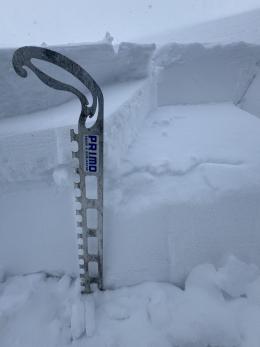This is Dave Zinn with pre-season avalanche, weather and event information for the Gallatin National Forest Avalanche Center on Tuesday, November 19th at 7:30 am. This information is sponsored by the Yellowstone Club Community Foundation and The Friends of The Avalanche Center. You can donate to the Friends of the GNFAC’s Fall Fundraiser HERE. We will update this bulletin as conditions warrant.
Mountain temperatures on Tuesday morning are in the single digits to teens F, some of the coldest we have seen this season. Winds are 5-15 mph from the west to the north, and the mountains received a fresh shot of snow.
- Bridger Range - 8” snow/0.6” SWE
- Hyalite Canyon - 7” snow/0.5” SWE
- Big Sky - 9” snow/0.5” SWE
- West Yellowstone - 5” snow/0.5” SWE
- Island Park - 7” snow/0.7” SWE
- Cooke City - 6” snow/0.6” SWE
Tuesday will feature the coldest temperatures of the week, with highs in the teens F and a lull in the incremental snowfall. Temperatures will warm, and chances for light snow accumulation will return in the second half of the week.
All Regions
The snowpack is thin, but we are heading in the right direction, with 5-10” of new snow falling in our latest storm. SNOTEL sites across the forecast area report snow depths between 16 and 26 inches, with the deepest totals in the Northern Gallatin and the Southern Madison Ranges. Hitting rocks, stumps and underlying obstacles remains the most likely hazard, but yesterday’s new snow increases the odds of triggering avalanches, especially in areas where wind-drifted snow built fresh wind slabs and instability within the new snow could result in storm slab avalanches.
Slopes with fresh wind slabs are the primary avalanche concern. The greater snow depths of wind-loaded slopes appeal to folks looking for early-season turns. However, these slopes are less stable and the most likely locations to encounter avalanches. Additionally, as snow drifts onto slopes, the potential size of slides increases. Recent indicators of this problem include shooting cracks in Beehive Basin on Monday (photo) and a natural wind slab avalanche in the northern Bridger Range on Sunday (photos and details). Increasing winds throughout the week, even without additional snow, can worsen this problem. Avoid steep slopes with signs of instability, which include recent avalanches, shooting cracks, collapsing (whumphing), stiffening of the snow surface, or visual cues of drifting.
Instability within or immediately below new snow may result in smaller storm slabs or loose snow avalanches. This problem is generally short-lived, but a quick snowpit will tell you if persistent weak layers that develop early in the season are resulting in longer-duration instability.
Getting captured in an avalanche of any size is likely to result in traumatic injuries, as victims will invariably hit the underlying obstacles during a ride. Thus, avoidance should be our objective. To reduce the consequences of a mistake, carry rescue gear, practice with it and follow safe travel protocols in and around avalanche terrain. Hunters, often traveling alone and without avalanche rescue gear, should avoid steep snow-covered slopes with more than a foot of snow.
Public observations are incredibly valuable as we develop a picture of the season's snowpack. Contribute to our community’s knowledge by submitting your observations, and look through our observation page for additional information before your next backcountry adventure.
Upcoming Avalanche Education and Events
Our education calendar is full of awareness lectures and field courses. Check it out: Events and Education Calendar
Thursday, November 21, 6-7 p.m., Free Avalanche Awareness for Families and Friends at Story Mill Community Center.
Tuesday, November 26, 6-7 p.m. Free Avalanche Awareness at REI Bozeman.
Monday, December 2, 6:30 p.m. MAP community partnership night and 1-hr Avalanche Awareness, at MAP Brewing
For an intro class with a field day, Register for our Avalanche Fundamentals course.
Friends of the Avalanche Center: Fall Fundraiser!
We’re still counting on your support and the online Fall Powder Blast fundraiser is 76% of the way to our goal. Please consider making even a small donation HERE or via Venmo
Read accident reports from previous early-season accidents before you venture to the snowy hills. This accident report from October 2012 in the northern Bridger Range, and this report from the tragic fatality six years ago in early October are reminders of the potential consequences of even a small avalanche.


